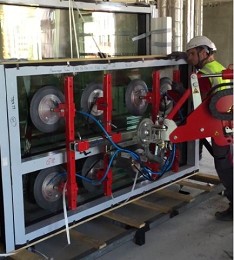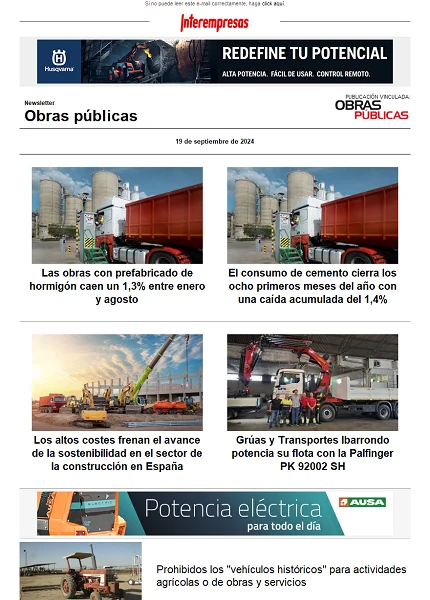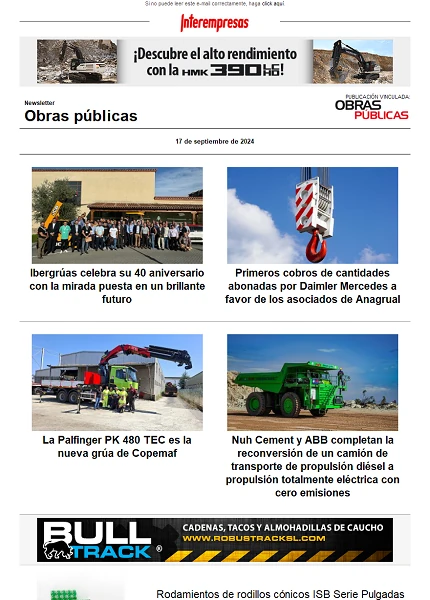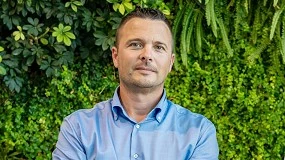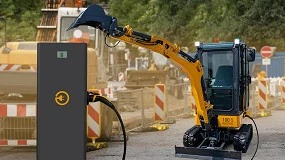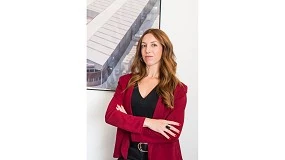Ecodiseño y ecoeficiencia en la maquinaria de la construcción y obra pública
13 de Octubre de 2008

Una de las principales conclusiones de la Conferencia de las Naciones Unidas de Río de Janeiro sobre el Medio Ambiente y el Desarrollo (Junio de 1992) fue que la reducción de los impactos ambientales generados por el hombre requiere de un compromiso no sólo por parte de los gobiernos, sino también por parte de las empresas, las organizaciones no gubernamentales y las comunidades científico-tecnológicas.
A nivel empresarial, este compromiso se ve reflejado principalmente en la implementación de los Sistemas de Gestión Medioambiental (SGMA), planteados como un conjunto de acciones y medidas que se toman de cara a contribuir al cumplimiento de la legislación vigente y a disminuir las agresiones que se generan sobre el ambiente. La incorporación de estas políticas en las compañías ha generado a su vez nuevos conceptos, como los de ecodiseño y ecoeficiencia, asociados al mismo objetivo: la reducción de los impactos ambientales de productos o servicios.
Ecodiseño y ecoeficiencia
reducen progresivamente los impactos ecológicos y la intensidad de recursos a lo largo del ciclo de vida a un nivel al menos adecuado a la capacidad estimada del planeta”. Por lo tanto, la ecoeficiencia se plantea como un objetivo, mientras que el ecodiseño aparece como una vía para su consecución.
Ecoeficiencia = Valor del producto o servicio / Impacto ambiental
El ecodiseño incorpora los aspectos ambientales como un nuevo criterio a considerar en la definición de un producto o servicio, basándose en una valoración del impacto medioambiental que generará a lo largo de toda su vida: desde la obtención de las materias primas y la utilización de recursos energéticos
primarios, pasando por las fases de fabricación, uso y mantenimiento, hasta su fin de vida (incluyendo el posible reciclado o reutilización). Evidentemente, este planteamiento establece un campo de acción ambiental de gran amplitud, que va más allá de las acciones correctivas o mejoras que suelen aplicarse en general sobre productos que ya están en el mercado. Por otro lado, la ecoeficiencia es el principal medio a través del cual las empresas contribuyen al desarrollo sostenible y al mismo tiempo consiguen incrementar su competitividad. Introduce una valoración económica del producto o del servicio en relación con su impacto ambiental, por lo que integra ambos aspectos.
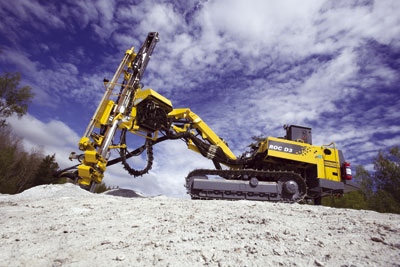
La utilización de metodologías de ecodiseño sobre un producto permiten disminuir desde su definición su impacto ambiental, con la consecuente mejora del índice de ecoeficiencia asociado.
A nivel empresarial, los países líderes en la incorporación de SGMA son Japón, China, España, Italia y Reino Unido. Sin embargo, existen otros países con un importante desarrollo, incluso superior al de los países anteriores, en temas concretos de ecodiseño y ecoeficiencia como Análisis de Ciclo de Vida (ACV), Diseño de fin de vida (reciclado, recuperación) o Estudios de Impacto Ambiental. Pueden destacarse entre ellos a Dinamarca, Alemania, Holanda, Austria, Suecia y Suiza. En todos ellos se evidencia una fuerte participación de organismos gubernamentales y no gubernamentales, institutos tecnológicos, universidades y empresas.
En España, los principales referentes tecnológicos en actividades relacionadas con el ecodiseño y la ecoeficiencia son el Instituto de Ciencias y Tecnologías Ambientales (Icta) de la Universidad Autónoma de Barcelona, que trabaja junto con el grupo de investigación SosteniPra y la Escuela Superior de Diseño Elisava e Ihobe, Sociedad Pública de Gestión Ambiental (País Vasco). Algunas otras instituciones que participan en proyectos y redes temáticas relacionadas son Gaiker (País Vasco), Aimme (Comunidad Valenciana), Ita (Aragón) y la Fundación Cartif (Castilla y León).
Descripción del estado del uso del ecodiseño y la ecoeficiencia a nivel nacional en el sector de la MOP
Sin embargo, las prácticas medioambientales en las empresas se limitan en la mayoría de los casos a medidas para la protección y el control de la contaminación (tratamiento de aguas, residuos y emisiones) y para el reciclado.
Evidentemente, el ecodiseño y la ecoeficiencia son conceptos mucho más amplios, que abarcan muchas otras medidas posibles, como las de reducción del consumo de energía, minimización del uso de materiales y utilización preferente de aquellos con bajo impacto ambiental, facilitación de la reparación y el mantenimiento, aumento de la durabilidad, reducción del uso de sustancias tóxicas y recursos naturales no-renovables, entre otras.
La incorporación de políticas ambientales en las compañías responde a un convencimiento de que esto les traerá beneficios futuros
Definición de la tendencia tecnológica en el sector de la MOP a nivel nacional e internacional
1) La legislación ambiental (influencia directa).
2) La presión que puede recibir el sector de sus clientes (influencia indirecta de la legislación) o de otros actores sociales.
Ambos factores se identifican claramente dentro de las empresas como razones de peso que justifican la realización de estudios de ecodiseño y ecoeficiencia. Por lo general, la incorporación de políticas ambientales en las compañías responde a un convencimiento de que esto les traerá beneficios futuros, relacionados en primer lugar con poder responder a los clientes y en segundo lugar con el simple cumplimiento de la normativa ambiental.
En el caso de la MOP, su principal cliente, el sector de la construcción, está sometido a una fuerte regulación medioambiental (como la introducida en el Código Técnico de la Construcción ), dado su alto nivel de impacto asociado. Es de esperar-se entonces que esta presión se traslade progresivamente también al sector de la MOP (principalmente en relación con el uso de los productos), conforme el nivel de exigencias vaya aumentando. Por otro lado, respecto a la influencia directa de la legislación ambiental sobre el sector, pese a que actualmente se limita a generar la mejora de determinados componentes concretos, es probable que surjan nuevas exigencias que fuercen al sector a una mayor utilización del ecodiseño y la ecoeficiencia.
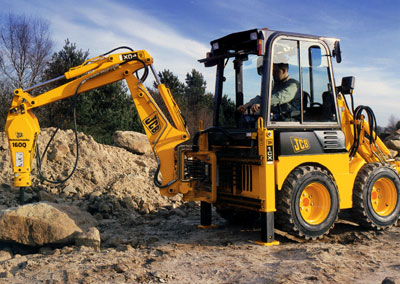
Posibilidades de uso del ecodiseño y la ecoeficiencia en la MOP
En el caso de la MOP es posible identificar una serie de fuentes de agresión al medioambiente como las de mayor influencia para este sector en concreto: emisiones, ruido, residuos, consumo de recursos en su fabricación o en uso, y daños a la salud de los usuarios y seguridad.
Respecto a las emisiones, principalmente asociadas a los motores de combustión utilizados, pese a que como se mencionó ya existe una legislación que está generando algunas respuestas concretas en el sector, la actividad es aún muy incipiente. El objetivo ecoeficiente marcado es el de llegar a niveles de emisiones considerablemente más bajos que los actuales (Tier4-StageIII) para todos los tipos de motores, como los utilizados en dumpers, carretillas, excavadoras, niveladoras, cargadoras, manipuladores, etc. En este sentido, hay mucho trabajo de ecodiseño pendiente por hacer, desde el estudio de nuevas tecnologías hasta la implementación de las soluciones que se generen. Aparecen también las posibilidades de los nuevos sistemas de generación de energía que, aunque hasta el momento no existen evidencias de que el sector de la MOP lo esté planteando como una vía de mejora de sus productos, constituyen soluciones de gran interés. Es probable que la utilización de otros combustibles (como el hidrógeno o el gas natural licuado) o de energías alternativas (como la solar), sobre las que se están realizando grandes avances en otros sectores como el de la automoción, llegue también a la MOP en el medio o largo plazo.
En cuanto al ruido, como clase de contaminación ambiental, existe una tendencia en la MOP en intentar minimizarlo (tanto para los propios operarios de las máquinas como para otras personas). Sin embargo, las soluciones en general apuntan más a agregar aislamientos acústicos que a intentar disminuir las fuentes del ruido. El ecodiseño, como herramienta, permitiría en estos casos evaluar ambos tipos de soluciones y definir cual es la óptima. En este sentido, podría aplicarse no sólo sobre la maquinaría mencionada anteriormente, sino también sobre maquinaria más pequeña como tronzadoras, cortadoras, pulidoras, perforadoras, dobladoras, andamios eléctricos, etc.
Respecto a la generación de residuos y su minimización, las tecnologías analizadas suelen aportar importantes mejoras no sólo en relación con la posibilidad de reciclado de los componentes, sino también en temas concretos de mantenimiento (repuestos), reutilización y aumento de la durabilidad. En el caso concreto de la MOP pueden ser medidas de gran interés. La minimización del consumo de recursos junto con la minimización del daño a la salud de los usuarios son criterios aplicables a toda la MOP en general, la implementación del ecodiseño y la ecoeficiencia se presentan también como vías de mejora de estos aspectos.
Finalmente, conforme se avance en estas temáticas medioambientales, la aplicación del ecodiseño y la ecoeficiencia podrán generar nuevos productos, una maquinaria que además de cumplir con los requerimientos funcionales logre reducir su impacto ambiental.
Retos y necesidades para la implementación en el sector
Independientemente de esto, otras dificultades que se pueden presentar están relacionadas directamente con la aplicación de las metodologías asociadas. En la realización de un ACV por ejemplo, en determinados casos puede no contarse con la información de partida necesaria para llevar a cabo el estudio. A partir de aquí, la valoración del impacto ambiental del sistema de producto analizado podría dificultarse enormemente, o incluso podrían generarse resultados cuya validez no se puede asegurar.
En cuanto a las necesidades de recursos, la implementación del ecodiseño y ecoeficiencia se llevan a cabo a través de una serie de metodologías específicas mediante las cuáles se podrán realizar las evaluaciones ambientales pertinentes. Algunas de las más utilizadas son por ejemplo los Análisis de Ciclo de Vida (ACV), las Evaluaciones de Comportamiento Ambiental, los Estudios de Impacto Ambiental (EIA), los Análisis de Riesgos Ambientales, las Evaluaciones de Eco-indicadores, entre otros. La realización de estos estudios requiere en la mayoría de los casos la utilización de programas de análisis específicos, bases de datos e información sobre los materiales y procesos involucrados, y usuarios experimentados que logren desarrollar los métodos adecuadamente. Sin embargo, en muchos casos estos estudios pueden subcontratarse, en cuyo caso las inversiones de I+D a nivel interno para el desarrollo del ecodiseño y la ecoeficiencia ya no tendrían por qué ser tan elevadas.
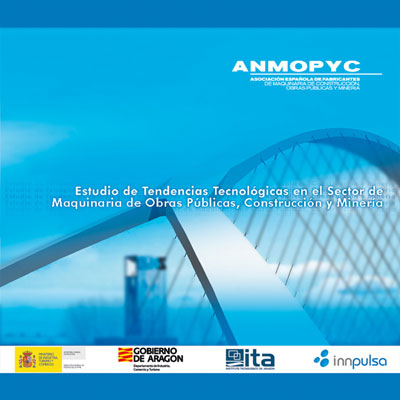
Evaluación del impacto de la aplicación de estas tecnologías
En segundo lugar, la utilización del ecodiseño y la ecoeficiencia ha demostrado ser una forma de aumentar la competitividad de las empresas. La mejora de la imagen corporativa asociada a los “productos verdes” o “amigables con el medioambiente” tiene efectos directos en el mercado dentro de una sociedad con una conciencia ambiental cada vez mayor. Esto es de particular importancia en el sector de la MOP, sobre el cuál no existe en general una imagen positiva desde el punto de vista medioambiental. Este aspecto puede concretarse sobre los productos en la obtención de las llamadas ecoetiquetas, nacionales o europeas, que certifiquen la sensibilidad ambiental de la empresa.
En términos estrictamente económicos, la utilización de las técnicas analizadas contribuye en muchos casos a la reducción de los costes asociados a la obtención y el tratamiento de las materias primas, a la producción y el consumo energético, al transporte y distribución de productos, y al tratamiento de los residuos generados. Los gastos asociados a seguros son en general más bajos para aquellas empresas que desarrollen políticas medioambientales. Existen además otros beneficios económicos que pueden conseguir las empresas por acogerse a los diferentes sistemas de gestión medioambiental promovidos por las administraciones.
Finalmente, la tendencia actual es claramente hacia regulaciones medioambientales cada vez más estrictas que en algún momento alcanzarán al sector de la MOP en forma más directa. Supone un cambio en el concepto tradicional del diseño que cuanto antes sea asumido por las empresas más fácil les será luego adaptarse a un entorno en el que la temática ambiental será de una enorme importancia.
Lógicamente, este cambio aportará nuevas soluciones y generará también nuevas oportunidades tecnológicas.




